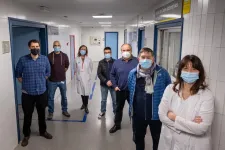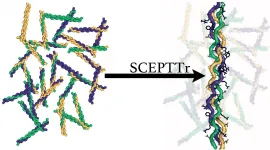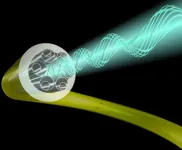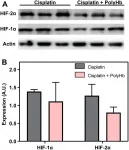INFORMATION:
Integrating maths and plant science to explain how plant roots generate a hormone gradient
2021-02-16
(Press-News.org) The research team that developed a biosensor that first recorded that a distinct gradient of the plant growth hormone gibberellin correlated with plant cell size has now revealed how this distribution pattern is created in roots.
Starting when a plant embryo forms within a seed and continuing throughout the plant lifecycle, undifferentiated stem cells undergo radical transformations into specialised root, stem, leaf and reproductive organ cells. This transformation relies on a suite of molecules called phytohormones that, much like human hormones, can move between cells and tissues and trigger distinct biological processes across the bodyplan. While it was not known at the time, mutations involving the gibberellin class of phytohormones were behind the development of many of the high-yielding semi-dwarf wheat and rice varieties that helped drive the Green Revolution in the 1950s and 60s.
The mutations resulted in shorter stems, enabling the crop plants to redirect energy into growing grain rather than stems and leaves and also prevented lodging caused when tall spindly plants fall over before harvest. We now know through advances in molecular and genetic tools that gibberellins (GA) regulate growth and development throughout the plant lifecycle - from germinating seeds, elongating stems and roots, to the formation of flowers. It is therefore not surprising that GA continues to attract the interest of plant scientists investigating how hormones control plant growth and as a possible target for future crop improvements.
A collaboration between the research teams of Alexander Jones, Sainsbury Laboratory at the University of Cambridge, and Leah Band and Markus Owen at the University of Nottingham, explain the biochemical steps responsible for a distinctive GA distribution seen in plant growth in PNAS today. Their research provides a valuable model for understanding GA patterns in other plant tissues and its related influence on plant development.
"As key regulators of plant growth and development, understanding plant hormones is crucial for understanding plant growth dynamics, how they respond to their environment, and to help identify future targets for improved food security," said first-author Dr Annalisa Rizza.
"GA is known to regulate cell multiplication and cell expansion to increase the growth root rate , but we as yet don't have a full picture of how. We had previously observed there was a distinct longitudinal gradient of GA from root tip to root elongation zone that correlated with cell size in growing roots of the model plant Arabidopsis thaliana. We also observed an exogenous-GA-generated gradient with faster accumulation of GA in larger cells, but we did not know how these patterns were being created."
To help find the answer, the researchers combined mathematical models with experimental observations to take a deep dive into the cells to see what biochemical and/or transport activities might be responsible.
Mathematicians from the University of Nottingham, Dr Leah Band and Professor Markus Owen, developed a computational model to simulate the hormone GA dynamics in the plant root, which enabled them to test how different processes contribute to the GA gradient. They compared the output of their computer simulations to the experimental observations from the GA biosensor developed by the Jones research group.
"Having considered various scenarios, we found that the model predictions could only agree with the GA biosensor data provided the elongation-zone cells have high GA synthesis and increased permeability" added Dr Band.
The next step was to test these predictions through experiments. Using the GA biosensor, the team examined the key steps involved in GA biosynthesis and pinpointed key rate limiting steps associated with enzymes involved in GA biosynthesis and that differential permeability in cell membranes were also playing a key role in creating GA gradients.
They showed that each region in the root has a different combination of important regulatory steps, a level of information that was previously not accessible to researchers. Even more surprising, an important step that was generally thought to be rate limiting was the least important for setting the position and slope of the root GA gradient.
In addition to local synthesis of GA, the ability of GA to move between cells is also considered an important factor. The team looked at the permeability of cell membranes to GA and found differences in cell permeability were contributing to the creation of the exogenous-GA-generated-gradient.
"Tiny amounts of these chemical hormones can reprogramme a plant cell and completely change its growth and physiology. Which plant cells produce these chemicals? Where and when do these chemical hormones go? These are the core questions that we are trying to answer," explained Dr Jones.
"These findings help explain which components are playing the important roles contributing to how plants control the distribution of a mobile hormone. There are multiple components involved in this - processes that make more GA, take it away and transport it from and into the cell all play a part. These can then be targets for engineering nuanced changes. The Green Revolution was great, but there are negative side effects that could be eliminated with more fine scale perturbations in the future.
"This detailed understanding of how GA distribution relates to root growth and how these gradients are controlled provides a valuable model for progressing our understanding of how hormone distributions influence how plants grow."
ELSE PRESS RELEASES FROM THIS DATE:
Dopamine is key to the mystery of metabolic dysfunction in psychiatric patients
2021-02-16
PITTSBURGH, Feb. 15, 2021 - Why do patients who receive antipsychotic medications to manage schizophrenia and bipolar disorder quickly gain weight and develop prediabetes and hyperinsulemia? The question remained a mystery for decades, but in a paper published today in Translational Psychiatry, researchers from the University of Pittsburgh School of Medicine finally cracked the enigma.
Antipsychotic drugs, scientists showed, not only block dopamine signaling in the brain but also in the pancreas, leading to uncontrolled production of blood glucose-regulating hormones and, eventually, obesity and diabetes.
"There are dopamine theories of schizophrenia, drug addiction, depression and neurodegenerative disorders, and we are presenting a dopamine theory of metabolism," said lead ...
Climate change forces rethinking of conservation biology planning
2021-02-16
For more than a decade, governments in countries across the world have made significant progress to expand their protected areas network to conserve the planet's biodiversity. According to a new study published in the journal Global Change Biology, the locations of these protected areas do not take into account the potential long-term effects of climate change in these protected areas.
Creating and managing protected areas, such as national parks, is key for biodiversity conservation. As the climate changes, however, species will disperse in order to maintain their specific habitat needs. Species that were in protected areas ...
New tool predicts the success of extubating patients on intensive mechanical ventilation
2021-02-16
Almost half the patients admitted to an intensive care unit (ICU) require invasive mechanical ventilation (IMV), a medical procedure that guarantees a sufficient supply of oxygen to their organs and tissues. The therapy involves connecting patients to a machine that substitutes their spontaneous breathing. In recent months it has been in general use in intensive-care patients affected by COVID-19.
Although it can often save a patient's life, invasive mechanical ventilation is not risk-free: there can be accidental injury during intubation or extubation or the muscles ...
New study of goals and beliefs during COVID-19 lockdown shows people still care
2021-02-16
A NEW study from the University of Chichester has shed light on how people coped psychologically with the sudden and life-changing disruption caused by COVID-19.
This new publication, by Chichester's Professor Laura Ritchie and PhD candidate Benjamin Sharpe, in collaboration with Professor Daniel Cervone of the University of Illinois at Chicago, provides a unique snapshot into people's understanding of their goals and self-beliefs amidst a shared, unexpected alteration of the daily landscape during lockdown.
Ritchie and colleagues collected their ...
Collagen structures get the royal reveal
2021-02-16
HOUSTON - (Feb. 15, 2021) - Collagen is the king of biological proteins, and now it has a SCEPTTr.
That's the handle of an algorithm developed by Rice University scientists who study natural and synthetic versions of collagen, which accounts for about a third of the body's proteins and forms the fibrous glue in skin, bones, muscles, tendons and ligaments.
The program -- full name, Scoring function for Collagen-Emulating-Peptides' Temperature of Transition -- accurately predicts the stability of collagen triple helices, the primary structure that forms fibrils.
The Rice team led by chemist and bioengineer Jeffrey ...
New hope for treating chronic pain without opioids
2021-02-16
According to some estimates, chronic pain affects up to 40% of Americans, and treating it frustrates both clinicians and patients--a frustration that's often compounded by a hesitation to prescribe opioids for pain.
A new study from the University of Michigan School of Dentistry confirms that a low dose of a drug called naltrexone is a good option for patients with orofacial and chronic pain, without the risk of addiction, said first author Elizabeth Hatfield, a clinical lecturer in the Department of Oral and Maxillofacial Surgery and Hospital Dentistry.
Naltrexone is a semisynthetic opioid first developed in ...
Luminescent windows generate energy from inside and out
2021-02-16
HOUSTON - (Feb. 15, 2021) - Rice University engineers have suggested a colorful solution to next-generation energy collection: Luminescent solar concentrators (LSCs) in your windows.
Led by Rafael Verduzco and postdoctoral researcher and lead author Yilin Li of Rice's Brown School of Engineering, the team designed and built foot-square "windows" that sandwich a conjugated polymer between two clear acrylic panels.
That thin middle layer is the secret sauce. It's designed to absorb light in a specific wavelength and guide it to panel edges lined with solar cells. Conjugated polymers are chemical compounds ...
International study reveals exceptional property of next generation optical fibers
2021-02-16
Researchers from the University of Southampton and Université Laval, Canada, have successfully measured for the first time back-reflection in cutting-edge hollow-core fibres that is around 10,000 times lower than conventional optical fibres.
This discovery, published this week in The Optical Society's flagship Optica journal, highlights yet another optical property in which hollow-core fibres are capable of outperforming standard optical fibres.
Research into improved optical fibres is key to enable progress in numerous photonic applications. Most notably, these would improve Internet performance ...
Oncotarget: Hemoglobin increases the effectiveness of chemotherapy in lung cancer
2021-02-16
Oncotarget recently published "Polymerized human hemoglobin increases the effectiveness of cisplatin-based chemotherapy in non-small cell lung cancer" which reported that unfortunately, a significant portion of NSCLC patients relapse due to cisplatin chemoresistance.
Administration of hemoglobin-based oxygen carriers is a promising strategy to alleviate hypoxia in the tumor, which may make cisplatin more effective.
The R-state PolyHb administered in this study is unable to deliver O2 unless under severe hypoxia which significantly limits its oxygenation potential.
In vitro sensitivity studies indicate that the administration of PolyHb increases the effectiveness of cisplatin under ...
New insight into antibody-induced protective immunity to COVID-19
2021-02-16
BOSTON -- While PCR testing has been used widely for COVID-19 diagnosis, it only provides information on who is currently infected. Antibody testing can tell who has been previously exposed to SARS-CoV-2, the virus that causes COVID-19, a metric that is essential for tracking spread across a population. It may also, as a study recently published in the journal Nature Communications shows, hold the key to understanding the immune response to the virus.
Led by Galit Alter, PhD, Core Member of the Ragon Institute of MGH, MIT and Harvard, this study found that while antibodies against SARS-CoV-2 may be a good way to measure exposure to the virus, their presence alone wasn't enough to determine if a person had long-lasting protection. Instead, antibody effector functions associated ...







